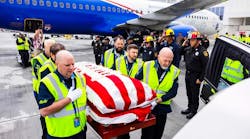NEW YORK, April 27, 2021 /PRNewswire/ -- Revenue in the aviation maintenance, repair, and overhaul sector (MRO) declined almost 40 percent in 2020, but it is starting to claw its way back as air traffic increases due to demand in leisure travel. Looking forward, the MRO industry will look different as it rebounds post-COVID according to Oliver Wyman's Annual MRO survey titled Recover and Rebuild.
"The MRO industry indicates that in the time since COVID hit, it has focused on the basics – labor and materials cost management. That said, spending on technology did not suffer as much as expected, indicating a commitment to technologies that really drive productivity and other efficiencies," said Derek Costanza, Oliver Wyman partner and lead author of the report.
The MRO industry recovery is underway, and more than 60 percent of respondents expect the MRO the sector to recover to 2019 levels in 2022 or 2023, in line with Oliver Wyman's forecast of recovery to pre-pandemic levels in 2022.
The annual survey of senior aviation executives explores trends and emerging issues in the aviation maintenance, repair, and overhaul sector. Key findings include:
- COVID-19's lingering effects on fleet plans and strategies are the primary disruptors
- Continued cost management and competitive positioning of original equipment manufacturers (OEMs) versus MROs in the aftermarket are other key concerns
- Airline respondents generally expect a slightly earlier recovery than MRO respondents likely as the airlines are one step closer to changes in passenger demand. In terms of regions, Western European survey respondents were more pessimistic than respondents in North America and other parts of the world on how long recovery will take given how the pandemic response with vaccinations and other protocols evolves.
- The survey also compared the tactics used to weather the pandemic across regions. For example, 89 percent of Western European airline respondents said they reduced headcount, while only 40 percent of North American airline respondents did so. Many carriers outside of North America were forced to cut capacity more severely due to travel restrictions, forcing them to make greater changes to their cost structures.
Labor Shortage Labor scarcity and limited talent pools remain a key issue facing the industry, especially around the lack of women entering the sector. Across maintenance and engineering organizations, women make up 12 percent of staff, with only 8 percent of women sitting in leadership roles. While survey respondents are supportive of inclusion and diversity (I&D) programs, only 9 percent believe I&D can help combat labor shortages.
"In a fight for talent, our industry must improve its ability to attract women, who are underrepresented in our ranks," said Brian Prentice, Oliver Wyman partner and co-author of the report. "While our industry generally feels good about its I&D progress there is a real disconnect between effort and actual results."
In an upcoming report on women in aviation, Oliver Wyman found that more must be done to improve the effectiveness of I&D programs. Sponsorship, mentoring, and coaching are critical in attracting more diverse talent. Furthermore, I&D must be a strategic business imperative for leaders and its goals as fundamental to business success.
About the MRO survey In its second decade, the annual Oliver Wyman MRO survey is an industry standard that samples the attitudes and strategies of executives from across the aviation industry as they address key trends and emerging issues in the maintenance, repair, and overhaul sector. In this year's survey, we focus on the long-term challenges that the pandemic has created, together with ongoing industry challenges. As in past years, we have leveraged the latest Oliver Wyman Global Fleet and MRO Forecast to provide additional insight.
More than 160 global aviation professionals responded to this year's survey, drawn from a cross section of airline operators, airline and independent MROs, original equipment manufacturers (OEMs), and others. Approximately half of respondents were senior executives (C-suite or vice presidents) and nearly 70 percent were director level or above. Over half of respondents' companies are headquartered outside of North America.



